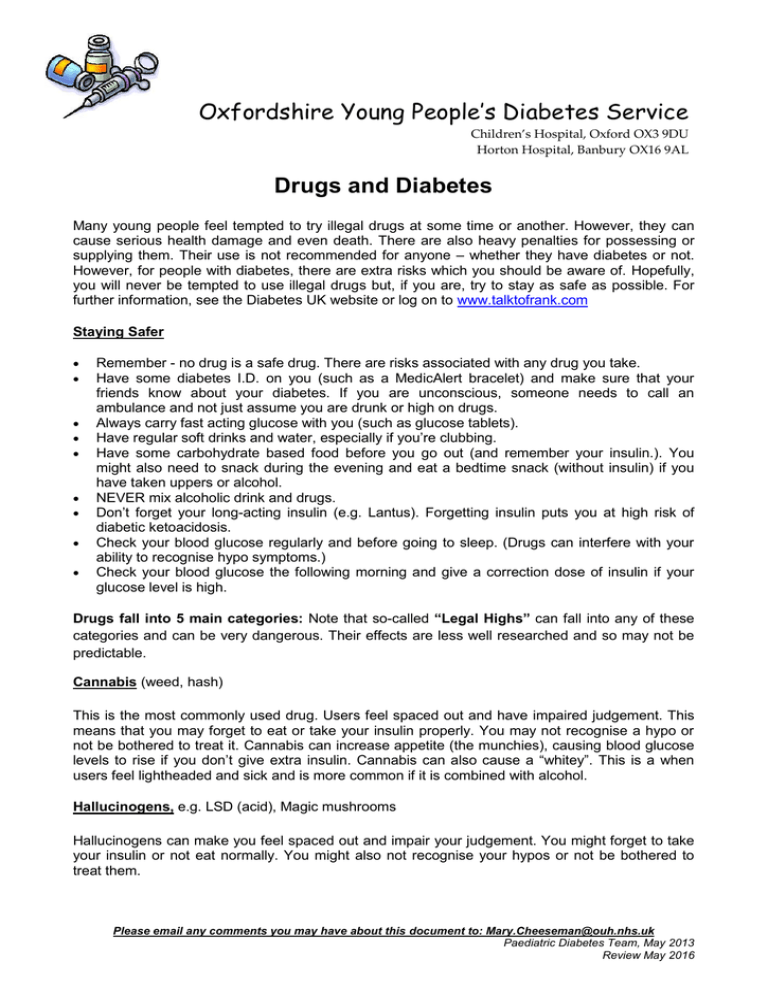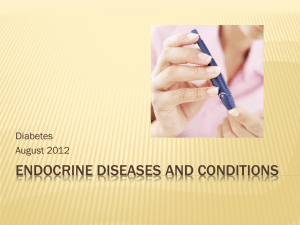Oxfordshire Young People’s Diabetes Service Drugs and Diabetes
advertisement

Oxfordshire Young People’s Diabetes Service Children’s Hospital, Oxford OX3 9DU Horton Hospital, Banbury OX16 9AL Drugs and Diabetes Many young people feel tempted to try illegal drugs at some time or another. However, they can cause serious health damage and even death. There are also heavy penalties for possessing or supplying them. Their use is not recommended for anyone – whether they have diabetes or not. However, for people with diabetes, there are extra risks which you should be aware of. Hopefully, you will never be tempted to use illegal drugs but, if you are, try to stay as safe as possible. For further information, see the Diabetes UK website or log on to www.talktofrank.com Staying Safer Remember - no drug is a safe drug. There are risks associated with any drug you take. Have some diabetes I.D. on you (such as a MedicAlert bracelet) and make sure that your friends know about your diabetes. If you are unconscious, someone needs to call an ambulance and not just assume you are drunk or high on drugs. Always carry fast acting glucose with you (such as glucose tablets). Have regular soft drinks and water, especially if you’re clubbing. Have some carbohydrate based food before you go out (and remember your insulin.). You might also need to snack during the evening and eat a bedtime snack (without insulin) if you have taken uppers or alcohol. NEVER mix alcoholic drink and drugs. Don’t forget your long-acting insulin (e.g. Lantus). Forgetting insulin puts you at high risk of diabetic ketoacidosis. Check your blood glucose regularly and before going to sleep. (Drugs can interfere with your ability to recognise hypo symptoms.) Check your blood glucose the following morning and give a correction dose of insulin if your glucose level is high. Drugs fall into 5 main categories: Note that so-called “Legal Highs” can fall into any of these categories and can be very dangerous. Their effects are less well researched and so may not be predictable. Cannabis (weed, hash) This is the most commonly used drug. Users feel spaced out and have impaired judgement. This means that you may forget to eat or take your insulin properly. You may not recognise a hypo or not be bothered to treat it. Cannabis can increase appetite (the munchies), causing blood glucose levels to rise if you don’t give extra insulin. Cannabis can also cause a “whitey”. This is a when users feel lightheaded and sick and is more common if it is combined with alcohol. Hallucinogens, e.g. LSD (acid), Magic mushrooms Hallucinogens can make you feel spaced out and impair your judgement. You might forget to take your insulin or not eat normally. You might also not recognise your hypos or not be bothered to treat them. Please email any comments you may have about this document to: Mary.Cheeseman@ouh.nhs.uk Paediatric Diabetes Team, May 2013 Review May 2016 2 Uppers (Stimulants), e.g. Ecstasy, Cocaine (snow), Amphetamine (speed, whizz) Uppers increase your metabolic rate. Users experience a temporary high and increased energy. Body temperature goes up and, if you’re dancing continuously, you can become dehydrated. They also increase your risk of hypos. This is because of the increased metabolic rate, increased exercise levels (such as prolonged dancing) and also because they reduce your appetite, so you may eat less than usual. Risks are reduced by eating a meal rich in long-acting carbohydrates (and taking your insulin as usual) before starting. You should also eat regular carbohydrate containing snacks (without insulin) and drink a pint of non-alcoholic, sugar-free drink each hour. (Do not drink more than this if using Ecstasy, as there is a risk of fluid overload.) Make sure you check your blood glucose and eat a carbohydrate snack (without insulin) before you go to bed. Once the high wears off, users experience “come down” and feel depressed, irritable and tired. Some people sleep for long periods and risk missing their usual insulin injections. The symptoms can last several days and cause difficulty concentrating at school or work. You might also feel less motivated to look after your diabetes properly. Ketamine (K, Green, Donkey dust) All users risk unconsciousness, hallucinations and high blood pressure. If you have diabetes there is extra risk as ketamine increases blood glucose levels and also can cause metabolic acidosis (which is similar to diabetic ketoacidosis). The risk of serious acidosis can be reduced by making sure that you do not forget any insulin. Opiates, e.g. Heroin (also known as smack, H, gear, brown, skag, horse), Codeine Opiates are highly addictive. They are “downers”, meaning that they slow down the body’s thought processes, heart rate and breathing. Vomiting can occur (particularly after the first dose), so hypoglycaemia could be a risk. The relaxing effect might mean that you forget about or can’t be bothered with taking your insulin, doing blood tests or eating properly. As a result, there is an increased risk of poor glucose control - both hypoglycaemia and high glucose levels/ketoacidosis. If you inject, you run the risk of skin infections that won’t heal properly, especially if your diabetes isn’t well controlled. Getting Help If you are worried about your drug use or that of a friend or relation, speak to a member of the diabetes team or contact the Oxfordshire Drug and Alcohol Action Team (DAAT). DAAT has a confidential service for the under 18s called Young Addaction. There is also a service for adults (over 18) which includes drop in clinics in Oxford, Banbury, Witney, Abingdon and Bicester. DAAT contact details: www.oxfordshiredaat.org or telephone 01865 403261 For Addaction, see the DAAT website as above or email oxfordshire@addaction.org.uk or telephone 01235 468405 Please email any comments you may have about this document to: Mary.Cheeseman@ouh.nhs.uk Paediatric Diabetes Team, May 2013 Review May 2016






